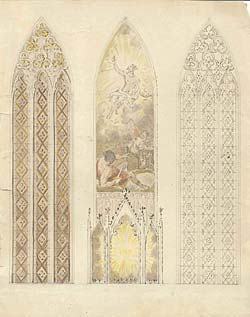In mediaeval times, the Diocese of Lichfield was one of the largest in England, covering a vast swathe of the north Midlands and the north west of England. It roughly coincided with Cheshire and south Lancashire, Coventry and north Warwickshire, Derbyshire, Shropshire and Staffordshire. In 1541 the diocese was reduced in size by the creation of the Diocese of Chester. There were further contractions and adjustments in the 19 th and early 20 th centuries to leave only Staffordshire and north Shropshire. Some of the earliest surviving archives, held by the Archive Service, were created by the Diocese of Lichfield in the course of its administration.
At the spiritual centre of the diocese is the cathedral church, one of the earliest places of worship in Britain. It is notable as the burial place of St Chad (d 672) and as the only cathedral in England with three spires, known as the ‘ladies of the vale’. Dating originally from the 7 th century, the cathedral attracted pilgrims to the shrine of St Chad from these early times, where, it was stated, miracles occurred.
Staffordshire had no great abbeys such as counties like Yorkshire. The most important monastic house in the county was the Benedictine abbey of Burton on Trent founded by Wulfric Spot, a Mercian nobleman, who left all his lands to endow the foundation in 1004. The dissolution of the monasteries by Henry VIII in the 16 th century left little in the way of monastic remains, the most extensive being at Croxden, a former Cistercian abbey.
Staffordshire has great variety in its many church buildings. There are fine examples of mediaeval church architecture, as well as examples of work by major Victorian architects such as AWN Pugin at Cheadle, Norman Shaw at Leek and Meerbrook and GF Bodley at Hoar Cross. The county is also notable for Ingestre church, designed by Sir Christopher Wren for Walter Chetwynd. The records, created by Anglican parish churches from all over the historic county, document not only church life, but also many aspects of past local activity in the villages of Staffordshire.
After the Reformation in 16 th century England, strongholds of Roman Catholicism persisted in some areas of the county, such as Brewood and St Thomas, near Stafford. These were where local Catholic aristocracy and gentry lived and where their houses could provide centres where Mass could be said. Of the towns, Wolverhampton was the strongest for Roman Catholicism in the old county. Growing toleration of Catholics by the end of the 18 th and beginning of the 19th centuries saw increases in the number of Catholic churches in the county. From 1850 Staffordshire was part of the Roman Catholic diocese, later archdiocese of Birmingham.
From the 17 th century onwards, Staffordshire was also a county strong in dissent or non-conformity. The last heretic to be burned at the stake was Edward Wightman, burned at Lichfield for his faith in 1612. There were plenty of examples of Presbyterian and Baptist congregations in the county from the 17 th century onwards. It was also in the 17 th century that the Quaker movement became strongly established in Staffordshire particularly in the Staffordshire Moorlands. In the 18 th and 19 th centuries, new strands of non-conformity, notably Congregationalism, Unitarianism and Methodism, flourished, particularly in the industrial towns and villages of the Potteries, the Black Country and the Cannock Chase coalfield.
The Jewish synagogue in Hanley was built in the 1870s and the land donated for the Jewish burial ground at Newcastle by the Duke of Sutherland. Immigration into the county in the 20 th century has ensured that diversity in religious faith has continued. Many places of worship for other faiths, sometimes re-using former religious buildings, have now been established. |

